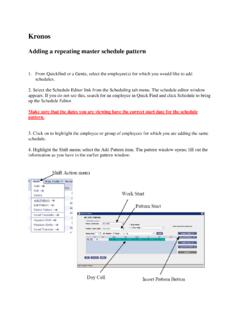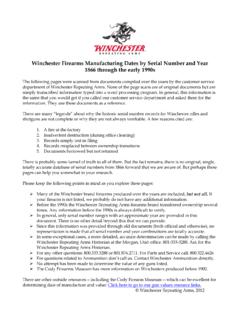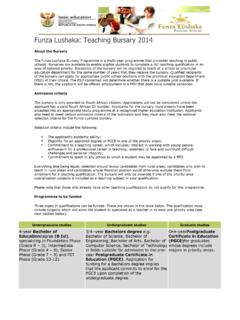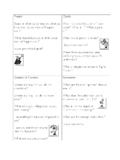Transcription of Justifying, Selecting and Implementing Tube …
1 justifying , Selecting and Implementing Tube Bending Methods Author: GREG MILLER. President/Owner Tubular Solutions, Inc. Medina, Ohio I. Introduction Companies considering the purchase of tube bending equipment are faced with an extensive set of alternatives. It is important that a potential purchaser research his needs and the various equipment available. The manufacturer who gives special attention to details will gain a significant edge over his competition. In this discussion we will investigate some of the more popular options available for tube bending, their benefits, limitations, cost and applications. A. REQUIRED BENDING DATA. Before an intelligent decision can be made, the potential purchaser must understand the basics of tube bending. Rather than delve into bending theory, we will look at the required physical information about the part.
2 The proposed machinery must have the physical and technical characteristics required to bend the part. The major factors influencing this are: a: Outside diameter (OD). b: Wall thickness c: Bending radius (usually measured from tube center line). d: Material e: Part configuration f: Bend quality required (ovality and wall thinning). Of particular interest in the selection of a bending method are items a, b, and c. These factors correlate to each other and will directly influence the type and tooling configuration of a tube bending machine. Modern design concepts generally develop a bent tube shape by cartesian coordinates. These points in space, X, Y, and Z dimensions mean nothing to a tube bending machine. Even the most advanced CNC machines will do nothing more with this information than convert XYZ coordinates to bending data.
3 Bending data can be defined as: a: Degree of bend sometimes called "angle". b: Distance between bends sometimes called "length", "feed", or "position". c: Plane of bend, sometimes called "twist", "rotation", or "orientation". It is imperative the potential purchaser understand what must be controlled in order to select the proper equipment. B. BENDING METHODS. There are various categories of tube bending equipment available on the market today. It is important a potential purchaser of a machine pay particular attention to required bending data and apply that knowledge to what is commercially available. "Re-inventing the wheel" can be very time consuming and expensive. Tube bending solutions, when approached methodically, can be obvious and profitable. 1.
4 Manual bending The original method of manual bending began with human power. Although bending a tube by hand is very economical, it is not conducive to higher production rates, quality or repeatability. To counter the adverse effects of bending strictly by hand, basic die sets with a mechanical method of producing leverage were developed. This increases the quality of the bend and the production rates attainable, as well as, decreasing the human power required. Although machines have been built with the leverage to handle 2" pipe, hand benders are generally suited for 1" or smaller tubing. Operation of this style machine requires that the operator place the tube in the tooling area at the proper bend position, actuate the tooling into position, and physically "pull" the machine mechanism to produce a bend.
5 Basic machines have a single dial, gage or adjustable stop which serve as a guideline to produce the desired degree of bend. When more than one bend per part is to be produced, the operator must index the part to the next bend point and repeat the process to the desired second bend angle. Advanced hand bending machines have been developed which are capable of producing parts similar to those by much more complex equipment. Systems have been devised to enable very accurate part positioning and to duplicate the method and quality of rotary draw bending. Physical "hard stops". have been built by manufacturers or "rigged" by end users to accomplish this. These advanced machines are significantly more expensive and utilize custom made tooling. The fact remains that the power for indexing between the bends, rotating for plane of bend and producing the bend angle is provided by the operator.
6 The advantages of basic manual tube bending equipment are: a: Low initial investment b: Short lead times for machine and tooling c: Simple to operate (if part configuration is unsophisticated). d: Portable e: Relatively safe to operate The disadvantages of basic manual tube bending equipment are: a: Maximum operator interface required b: Limited capacity c: Cannot be automated d: Standard OD and CLR tooling is limited e: Difficult to produce complex part configurations f: Accuracy and repeatability in question As a general rule of thumb, hand benders are best utilized for: a: Lower volumes b: Short runs c: Small diameters d: Basic part configurations e: Low labor rates Prototype areas, short run departments, job shops, remote location tube fabricating and situations where economical labor can be applied are all good applications for manual bending machines.
7 2. Semi-automatic bending For this discussion, we will characterize semi-automatic tube benders as fundamental hydraulic or electric motor powered tube and pipe bending machines. This equipment is available in many sizes, shapes and features. The most basic semi-automatic benders have degree of bend stop(s) connected to a control panel. "Stops" are either a physically set limit switch or electronic relay logic system. These machines can require manual positioning of the tooling or provide powered tool positioning via the control panel. The operator actuates the cycle via push-button and the machine bends the tube to the preset angle. After the bend is made, the operator physically indexes the part forward to the next bend position, actuates the return sequence and repeats the process.
8 Most machines come with several distance between bend stops. Distance between bend stops are usually adjustable physical "paddle" stops mounted on a rod running the length of the machine. The operator secures them to the desired distance between bend position. The trailing end of the tube contacts the stop and provides a way of repeating the distance between bend portion of the part configuration. Basic machines require that the operator rotate the part to the plane of bend position. This is perhaps the most difficult operation in the process to achieve accuracy and repeatability. A "bubble gage" is the main method of achieving this orientation. Hard stops can then be "rigged" or built into the tooling to provide a method for repeating the position. More advanced semi-automatic benders are almost like "NC" controlled machines.
9 Bender manufacturers are now offering several options to alleviate the drawbacks of the basic machines. Features available are: a: Digital input of part data and part number storage. Although actual machine control is limited to degree of bend sequencing and springback, this feature provides a method for storing valuable data about each individual part configuration. b: Carriages/colleting arrangements which hold the trailing end of the tube. This system enables physical plane of bend stops and distance between bend stops. However, the operator provides the physical force required to position the part. Significant advantages of this type equipment over manual machines are: a: Increased capacity b: Less physical operator interface c: More available options d: Suited for higher volumes e: Standard machines are generally more accurate f: Capable of more difficult applications Disadvantages of semi-automatic bending are: a: Labor input directly effects accuracies and production rates b: Requires operator expertise c: Accuracy and repeatability can sometimes be a problem d: Limited part complexities e: Difficult to automate 3.
10 CNC bending "Computer Numeric Controlled" (CNC) tube benders were developed to circumvent the problems associated with other methods. Modern computer technology linked with servo-mechanical control offers an excellent method for controlling the 3 bending axis'. CNC bender mechanics operate very similar to the other methods. The difference is that servo drives control the distance between bend and plane of bend. A carriage/colleting system is standard equipment. Tooling movement and sequencing, part data storage, and other items to be discussed later are controlled by the computer automatically. For the purpose of this discussion, a CNC bender will be defined as a self-sequencing tube bending machine. The operator hands the machine a part, actuates the start button, the machine bends the part, the operator removes it, actuates the return sequence and repeats the operation.








